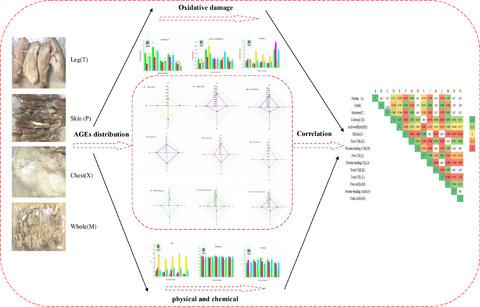当前位置:
X-MOL 学术
›
Food Sci. Nutr.
›
论文详情
Our official English website, www.x-mol.net, welcomes your
feedback! (Note: you will need to create a separate account there.)
Content of free and protein‐binding Nε‐carboxymethyllysine and Nε‐carboxyethyllysine in different parts of braised chicken
Food Science & Nutrition ( IF 3.5 ) Pub Date : 2020-01-09 , DOI: 10.1002/fsn3.1317 Zongshuai Zhu 1 , Rui Fang 1 , Yiqun Cheng 1 , Iftikhar Ali Khan 1 , Jichao Huang 2 , Bin Li 3 , Ming Huang 1
Food Science & Nutrition ( IF 3.5 ) Pub Date : 2020-01-09 , DOI: 10.1002/fsn3.1317 Zongshuai Zhu 1 , Rui Fang 1 , Yiqun Cheng 1 , Iftikhar Ali Khan 1 , Jichao Huang 2 , Bin Li 3 , Ming Huang 1
Affiliation

|
In order to illustrate the levels of advanced glycation end products (AGEs) in Chinese traditional braised chicken, the distribution of free and protein‐binding Nε‐carboxymethyllysine (CML) and Nε‐carboxyethyllysine (CEL) in four parts of processed chicken including chest (X), leg (T), skin (P), and the mixed whole body (M) was investigated. Our results showed that the content of free CML was 1,186.63–1,795.43 ng/g meat and protein‐binding CML was 11,693.91–16,122.90 ng/g meat. Differently, the content of free CEL was 24.81–41.62 ng/g meat and protein‐binding CEL was 270.11–385.49 ng/g meat. It was found that the total contents of CML were 31.5–56.8 folds higher than those of CEL. Protein‐binding AGEs (CML + CEL) were 6.6–9.9 times higher than those of free AGEs (CML + CEL). Pearson's correlation of AGEs and oxidation in four parts of braised chicken were also investigated, and the results showed that oxidation had a significant effect on levels of CEL; especially, the protein carbonyl was negatively correlated with free CEL (p < .05). TBARs value was significantly positively correlated with protein‐binding and total CEL (p < .01). In conclusion, our findings are important for better understanding of the AGEs formation in braised meat.
更新日期:2020-01-09











































 京公网安备 11010802027423号
京公网安备 11010802027423号